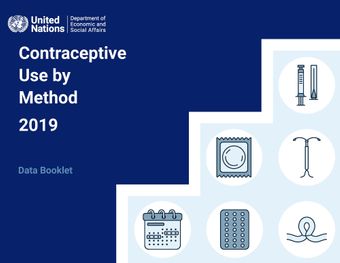Contraceptive Use by Method 2019
Data Booklet

Abstract
This data booklet highlights estimates of the prevalence of individual contraceptive methods based on the World Contraceptive Use 2019 (which draws from 1,247 surveys for 195 countries or areas of the world) and additional tabulations obtained from microdata sets and survey reports. The estimates are presented for female and male sterilisation, intrauterine device (IUD), implant, injectable, pill, male condom, withdrawal, rhythm and other methods combined.
© United Nations
Table of Contents
Introduction
Worldwide, 922 million women of reproductive age (or their partners) are contraceptive users
Female sterilisation and male condom are the two most common methods used worldwide
Contraceptive methods most commonly used vary widely by region
The prevalence of sterilisation, IUD and traditional methods has declined worldwide since 1994
Numbers of users of all methods (apart from male sterilisation and rhythm) have increased
In one fifth of Countries, one contraceptive method accounts for half or more of all contraceptive use
Female sterilisation and IUD are highly prevalent in only a handful of countries
The contraceptive pill and male condom are commonly used methods in many countries
Permanent and long-acting methods are more common in Asia and in Latin America and the Caribbean
Short-acting contraceptive methods are more common in sub-Saharan Africa and Europe
Methods designed to be used by women account for most contraceptive use
Methods used by married women are different from those used by unmarried women
Data on the contraceptive method mix have become increasingly available
Key indicators
Notes
Definition of Indicators and Contraceptive Methods
References
Worldwide, 922 million women of reproductive age (or their partners) are contraceptive users
Female sterilisation and male condom are the two most common methods used worldwide
Contraceptive methods most commonly used vary widely by region
The prevalence of sterilisation, IUD and traditional methods has declined worldwide since 1994
Numbers of users of all methods (apart from male sterilisation and rhythm) have increased
In one fifth of Countries, one contraceptive method accounts for half or more of all contraceptive use
Female sterilisation and IUD are highly prevalent in only a handful of countries
The contraceptive pill and male condom are commonly used methods in many countries
Permanent and long-acting methods are more common in Asia and in Latin America and the Caribbean
Short-acting contraceptive methods are more common in sub-Saharan Africa and Europe
Methods designed to be used by women account for most contraceptive use
Methods used by married women are different from those used by unmarried women
Data on the contraceptive method mix have become increasingly available
Key indicators
Notes
Definition of Indicators and Contraceptive Methods
References



